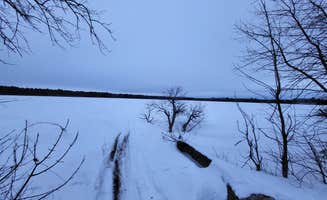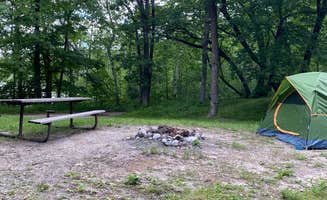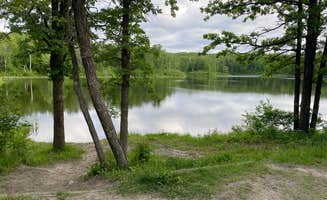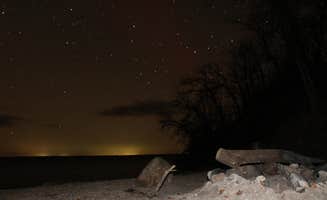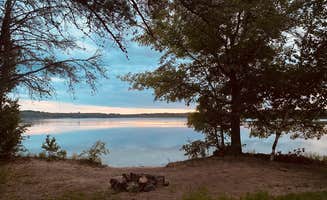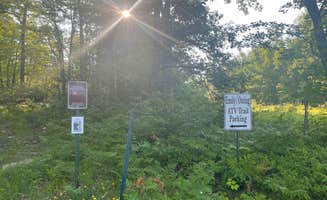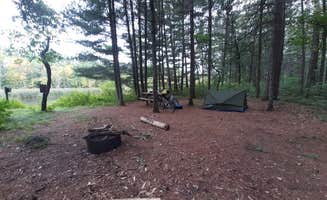Primitive camping near Cass Lake, Minnesota offers backcountry experiences on multiple waterways within the Chippewa National Forest and Paul Bunyan State Forest. Winter camping remains viable at select locations with proper preparation, as forest service roads may become snow-packed but still navigable. Cell phone coverage varies significantly throughout the area, with complete dead zones in remote locations.
What to do
Paddling chain lakes: The Little Gulch Lakes chain provides excellent canoeing opportunities with clear, pristine waters. "The lakes are clear and pristine, and far from crowds although within an easy drive of Akely, Bemidji, Itasca and Park Rapids. This is a great destination for canoeing or kayaking from lake to lake, all along a unique glacial moraine with deep quiet forests," according to a reviewer at Little Gulch Lake canoe campsite.
Trail access camping: Camp directly off the North Country Trail for easy hiking access. "The North Country Trail passes by this site and most sites on the NCT are free! This free site is a very short walk from a parking area/trailhead. Because it's on the NCT, the trail that passes the camp is extremely well maintained and groomed, not to mention super wide," notes a camper at Shingobee Recreation Area.
Mississippi River water trail: Follow established paddling routes with designated campsites along the river. "This is a paddle-in only campsite within the Chippewa National Forest, and is an official campsite on the Mississippi River State Water Trail in Minnesota. It is located downstream from the Lake Winnie Dam, and is a good place to stay after portaging the dam," shares a paddler about Crazy James Water Trail campsite.
What campers like
Secluded lake access: McCarty Lake offers primitive camping with convenient water entry points. "Very nice area with a water access, fire pit and outhouse. About a 10-15 min drive from main road and there are more campsites to find further in," reports a visitor to Halverson Trail Camp on McCarty Lake.
Wildlife viewing: Many dispersed sites provide opportunities to observe native birds and animals. "The campsite was perfect. There is a bench, firepit, latrine and multiple campsites. Very scenic view with the sounds of loons and frogs in the background. I have camped there twice and have never come across another hiker," explains a camper at Waboose Lake.
Shelter from wind and weather: Forested sites provide natural protection from elements. "My husband said it would be a great winter camping site, as it's more sheltered in the trees than some sites are. Plus in the winter, this trail is groomed for Cross Country Skiing, so it would be super accessible as a camp if you were skiing," notes a reviewer about Shingobee Recreation Area.
What you should know
Water source considerations: Most primitive sites lack treated water sources. "There is no well or pump or other water source at this campsite, and though the water is basically clear and clean you should either bring your own water jug or plan to boil or filter the nearby lake water as there is a lot of beaver activity in the area," advises a visitor to Little Gulch Lake.
Limited site capacity: Some dispersed sites accommodate only one group. "There's only room for one group to camp here so if you get there early it's pretty secluded except for a few drivers who come by to see if the spot is open," explains a camper at Little Gulch Lake canoe campsite.
Insect conditions: Be prepared for seasonal bug populations, especially near water. "It is extremely buggy and there's a large wasp nest/tunnel system on the ground near the fire pit," warns a reviewer about Little Gulch Lake campsite.
Tips for camping with families
Introductory wilderness experiences: Certain sites work well for easing children into backpacking. "If you have little ones that you are trying to 'wean' into camping, this would be a great place to take them to get a feel for the woods," suggests a camper at Shingobee Recreation Area.
Overflow options: Some sites offer additional space for larger family groups. "Across the trail (directly across from the camp) is a small little meadow type area that would be a perfect spot for 'overflow' tents, if you have more in your group than the site can take," notes a reviewer at Shingobee.
Lake view sites: Consider lakefront locations for easier supervision and activities. "Literally right between the road and lake winnibigoshish. Really beautiful spot. There is a fire ring on the 'beach' and one next to the tent pads," describes a visitor to D29 dispersed site.
Tips from RVers
Site accessibility: Forest roads vary significantly in maintenance and clearance requirements. "I would not recommend it if you have low clearance or are not confident in maneuvering your vehicle/trailer," cautions a visitor about D57 Upper Pigeon Lake regarding the access road.
Group camping options: Some sites can accommodate multiple vehicles. "Very large easy to access camping area. Could easily get 4-5 campers in this one. It is a bit rocky and not extremely level but open and better for less bugs. ATV trail leads right off camping area," notes a reviewer about Paul Bunyan State Forest Dispersed camping.
Parking considerations: Note the length and surface quality of designated parking areas. "The tent pad isn't huge, but could easily accommodate a 2 or 3 person tent. Maybe larger if you wanted to try," mentions a camper at Waboose Lake regarding site limitations.


